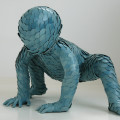Excerpt from The cult of manipulation: photography at the fringes of reality.
In an unusual 15th century Renaissance painting titled The Healing of Deacon Justinian by Fra Angelico, a miraculous tale of transformation is told. Two saints, Cosmas and Damian, take the leg of a recently deceased Ethiopian man and sew it to the sleeping Deacon, whose own diseased leg has been amputated.
For decades, the Moroccan multimedia artist Mounir Fatmi has been fascinated by it. In his latest exploration of the painting, The Blinding Light, which is on show at Paris Photo, he has created an eerie series of images which overlay Angelico’s original work with photographs shot in modern, hi-tech emergency rooms during real operations. Through the fusion of manipulated layers, critical details intertwine – it is as if the present-day doctors are attending to the deacon himself.
“The transparency between the two images creates a new dimension – it’s neither present nor past,” says Fatmi. “In the original painting the miracle is about God and religion, and in my photography it’s about science. So here we have science and religion running in parallel.”
There are three prints in Fatmi’s series (and one on a mirrored surface), each doctored differently. In one, the deacon is black-skinned while his new leg is white, reversing the racial relationship of the original painting.
Fatmi’s work is indicative of a palpable trend for transmuted imagery at this year’s Paris Photo. At almost every turn, these peculiar visions seem to eclipse their straighter, more traditional photographic counterparts. “Since the beginning of photography, all photographic imagery is manipulated in one sense or another,” Fatmi argues. “I think that images are created to be manipulated. Over time the image becomes something else.”





























